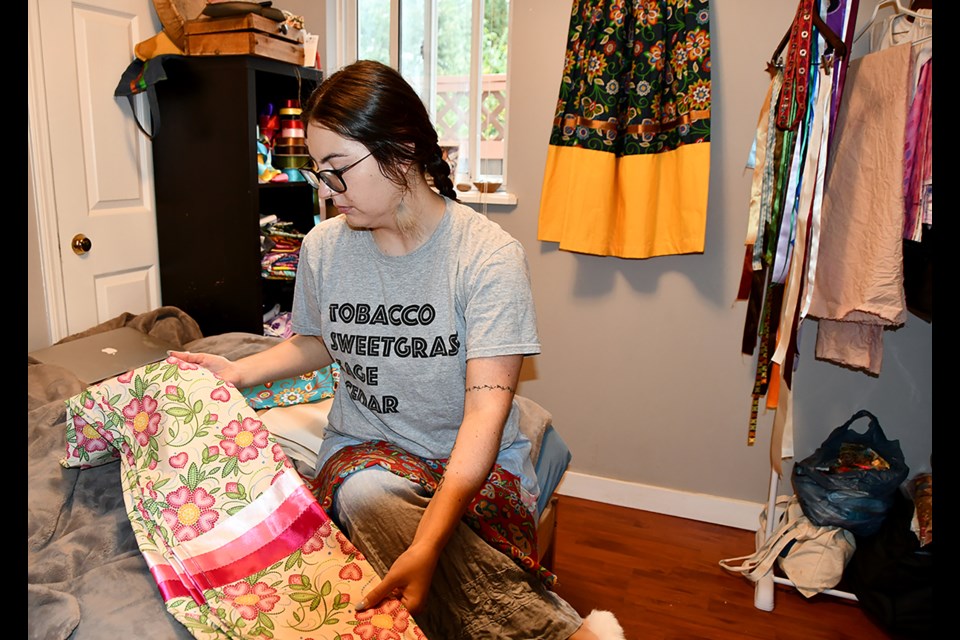Alexa Lizotte uses tongs to pull cotton ribbons, soaking in vinegar, from a boiling pot.
The Port Coquitlam sewer is experimenting with natural dyes on 100 per cent cotton, dipping the material in liquified dark red kidney beans, and a turmeric blend.
The colours and processes are the same as what her Métis ancestors have used for years.
And she’s continuing their legacy of returning to the Earth to find ways to create.
Indeed, the brand for her new business has a distinct eco-focus: Desert Métis Creations.
Desert refers to Las Vegas, the place where she was born and grew up, but left at 18.
She moved to Vancouver, where she got her bachelor of arts degree in psychology and sociology and reconnected with her Métis roots by working part-time with the Urban Nation Youth Association (UNYA) at Commercial Drive and East Hastings Street.
There, she was a counsellor for five years to help kids living in the Downtown Eastside.
Move to North Vermilion
But the same month the COVID-19 pandemic hit, Lizotte sought a deeper connection to her familial roots and moved to her Métis father’s village — eight hours north of Edmonton.
The North Vermilion Settlement, aka Buttertown, is across the river from Fort Vermilion, and is the place her dad escaped as a survivor of the Boyer River Indian Day School.
In that community, Lizotte told the Tri-City News she felt at home and became a Métis Nation of Alberta (MNA) citizen.
At its local office, she was as a community navigator and flood recovery worker, gaining further insight into the impacts of climate change while building Desert Métis, her sustainable fashion business.
Lizotte said the COVID-19 lockdown gave her time to finish her beaded projects that she had started at UNYA — which eventually led her to develop Desert Métis professionally.
She did flat-stitch beadwork for moccasins and earrings, as well as some beading around an eagle feather that was gifted to her from an Elder after a summer camp at UNYA.
She then beaded two smaller eagle feathers, found at a Richmond park, for her brothers.
But once she posted eight pairs of her beaded earrings on her Facebook page and they instantly sold, Lizotte knew she was on to something.
“I thought, ‘It’s not just me who thinks my works looks nice,’” she said. “Their feedback was really encouraging for me.”
Desert Métis, a name inspired by her mother and grandmother, has also had success on other digital platforms such as Instagram (@DesertMetis) and Etsy, an e-consumer site.
Pivot to education
Now, she wants to expand her business with educational components, offering workshops that tie Métis traditions and knowledge with climate–positive wardrobe choices.
Last month, Lizotte led an MNA workshop on cultural sustainability in fashion, teaching Métis about how traditional customs translate to fashion and environmental protection.
Run by the MNA’s Environment and Climate Change Department, her workshop was the first session in a series on climate change, climate action and environmental protection.
As Métis are known for their brightly coloured floral motif in their beadwork and embroidery — giving them the name “Flower Beadwork People” — Lizotte said she weaves in stories about the Ukrainian and French influences in their artwork and shares teachings about how her ancestors dyed fabric using the juices of beets and berries.
With her workshops, she hopes younger generations of Métis will carry on their culture.
“We have to remember that Indigenous and Métis have been leaders in climate health.”
You can see Alexa Lizotte teach beadwork on her YouTube channel: @desertmetis.





